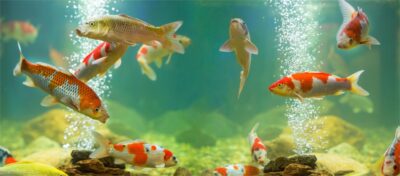Every fish or koi pond keeper should keep a supply of pond salt on hand at all times. Pond salt not only helps to strengthen your koi’s natural defenses against disease, but it also helps to decrease the effects of nitrate toxicity and provides helpful electrolytes to the water. Most significantly, when taken at the recommended amount, it will eliminate the majority of pond parasites.
We recommend that you always seek the advice of a specialist before performing any treatment. Be careful, salt is not compatible with other treatments. It will be necessary to make a change of water to evacuate it. You should also measure the salt level if you are using other products.
Non-iodized salt, Sodium Chloride (NaCl), is the finest salt to use in koi and goldfish ponds. It should not include any ingredients that might harm your fish. YPS (Yellow Prussiate of Soda) is an anti-caking ingredient found in several water softener salts. YPS is toxic to fish. It is affordable, safe to use, will not affect your biological filter, is effective in treating parasites, and aids in the battle against nitrite toxicity.
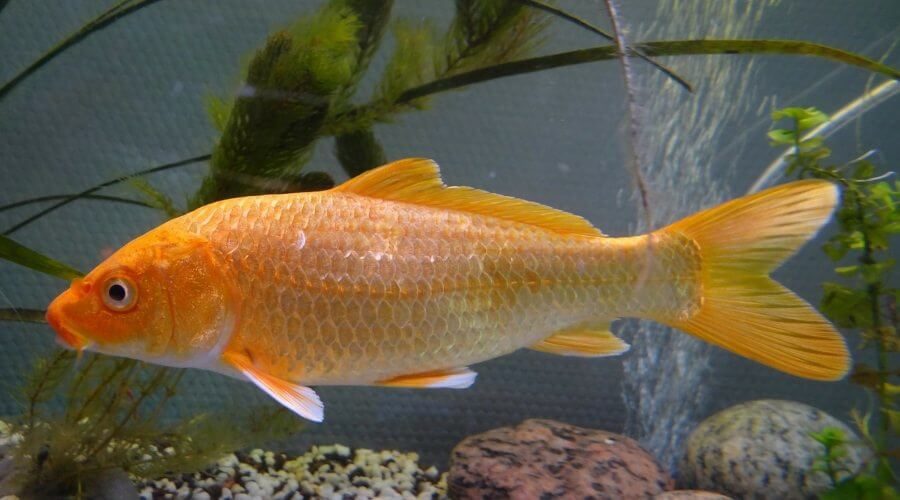
It is recommended that you take salt before attempting any other parasite treatment because it has so many advantages over other medicines.
Why Should I Put Salt in My Koi Pond?
‘Why should I use salt in my koi pond, and how much should I add?’ is a popular question among pond caretakers. Pond salt, when applied correctly, may provide several benefits to koi carp and pond water.
Pond salt was the go-to option for eliminating parasites and safeguarding koi carp throughout the winter months before there was a wide selection of pond treatments available on the aquatics market. During the winter, salt aided koi by replacing the salt that the fish naturally generate. When the temperature of the pond drops, the fish’s metabolism slows and their organs begin to work less efficiently than they would in warmer water. Using a tiny quantity of salt helps to replenish the natural salt they would typically generate but are unable to do so owing to the slower functioning — making winter more pleasant.
Why Do We Use Sodium Chloride (NaCl) and Non-iodized Salt?
With a low-cost solution that works with your biological filter, salt may help cure parasites, prevent nitrite toxicity, and increase mucous slime coat production. In this blog post, we discuss winter pond preparation and survival.
We use salt for Koi for two major reasons, both of which are related to keeping the fish healthy:
To get rid of parasites and/or germs on a Koi’s body, use salt:
We recommend that you always seek the advice of a specialist before performing any treatment. It is advisable in case of parasites to treat the fish in a quarantine tank. Be careful, salt is not compatible with other treatments. It will be necessary to make a change of water to evacuate it. You should also measure the salt level if you are using other products.
Koi are freshwater fish. Parasites and bacteria do as well. A koi pond salt treatment aids in the removal of freshwater parasites and germs. Personally, I believe that parasites are getting increasingly resistant to salt and that salt seldom kills parasites, but it still works effectively for things like columnaris bacteria.

By balancing a Koi’s osmoregulation, you can enhance illness recovery:
To clarify, a Koi is a freshwater fish; yet, because the salt level of its bodily fluid is considerably greater than that of the surrounding water, water continues to enter its body. Its body does not explode because it can excrete water as urine and so maintain its equilibrium. When a Koi becomes ill or agitated, it disrupts the body’s function of regulating osmotic pressure. To aid with this, we can add salt to the koi pond to get the salt content closer to that of a Koi’s bodily fluid. This reduces the amount of water that enters its body. The benefit is that the Koi’s body does not have to work as hard, allowing the Koi to recuperate faster.
“One additional benefit of salt is that it is not a medication. As a result, we don’t have to be concerned about any negative effects.”
The Advantages/Benefits of Adding Salt to a Koi Pond
It’s a heartbreaking sight to see your favorite Koi fish infected. Salting koi fishes can sometimes assist to fix small problems with these goldfish. There are several advantages to utilizing salt in a koi pond. Salt is mostly utilized to create a barrier against germs and parasites. Before any particular pond treatment was available, people utilized salt as a go-to remedy for parasite concerns.
we’ll go through some of the reasons why utilizing salt in koi ponds is beneficial :
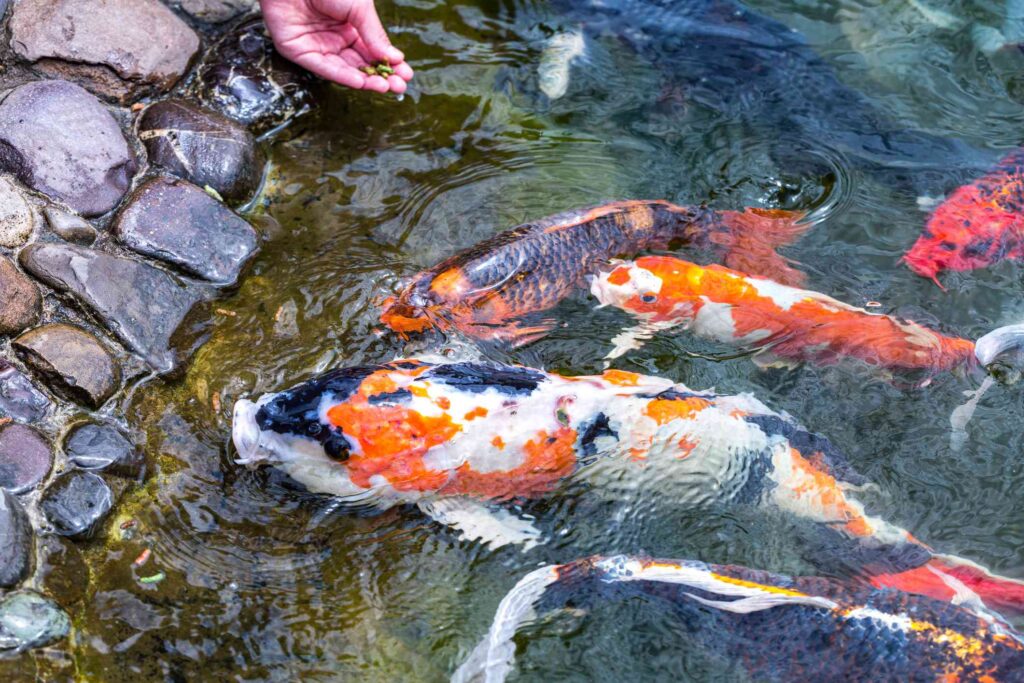
The Organ Function of Fishes Become Balanced
In the winter, salt preserves the fish. When the temperature drops and the pond water begins to freeze, the fish’s metabolism slows and the organs begin to work less reactively than usual.
Furthermore, the cold reduces the fish’s natural salt production. The use of salt in the pond substitutes the natural salt that the fish create, making winter simpler and more pleasant for the fish.
Getting Rid of Parasites and Bacteria
Another advantage of utilizing salt in the koi pond is that it kills 7 of the 9 parasites that are commonly present in the pond. Some salt can help to mitigate the symptoms of nitrate poisoning.
The addition of salt to pond water increases the formation of mucus slime coats. This slime coat protects the animal against parasites, germs, and other poisons in the water. Be careful, salt is not compatible with other treatments. It will be necessary to make a change of water to evacuate it. You should also measure the salt level if you are using other products.
Taking Care of Koi
Using salt in a pond is also useful for healing ill or weakfish. Koi is a freshwater fish, and its bodily fluid has a considerably greater salt content than the surrounding water. As a result, water enters its body and leaves as urine.
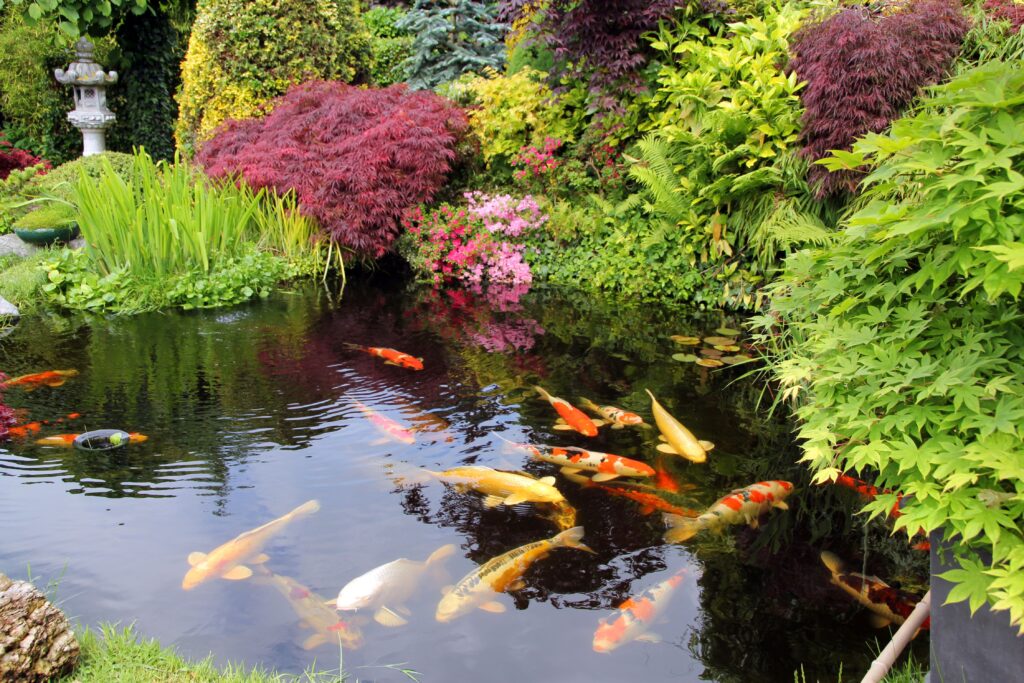
When a Koi fish becomes ill or disturbed, the osmotic pressure balancing mechanism is disrupted. The fish are relieved of the imbalance when salt is added to the water. It also contributes to the koi’s natural defense against illness.
If your koi are infected with germs or parasites, isolate them in a separate tank filled with pond water. You’d need to add 5 cups of salt for 100 gallons of pond water [Please don’t get this mixed up with tap water].
You’ll keep an eye on the koi in the quarantine tank to see whether they require any more treatment. In most situations, this is sufficient.
Enhances Water Quality
If you’re still wondering why you should add pond salt, here’s another reason. Pond salt enhances the overall quality of the water. It provides essential electrolytes to the water, which benefits physical wellness from the heart to the eyes.
There are no side effects
This is another reason why salt is used in koi ponds. Unlike other medications, putting the appropriate amount of pond salt in the pond is quite helpful and has no negative effects on any living organisms.
Furthermore, it is highly cost-effective to pick pond salt over any chemical or pharmaceutical.
To know more about salt benefits check out our article on Benefits Salt Koi pond!
Salt-Related Advice & Tips:
- Caution: Whenever salt is used, it should be dissolved in a bucket of pond water before being put immediately – undissolved salt can irritate fish gills and cause injury or death.
- Iodized salt should never be used since iodine is harmful to fish.
- Use caution when adding any type of salt to an aquatic tank since it can be harmful to plant life.
- Before adding salt to a tank, ensure sure that all zeolite products have been removed.
- After performing a salt treatment, use Microbe-Lift Ammonia Test Strips to check the water for ammonia spikes, since fish tend to excrete high amounts of ammonia after being exposed to salt.

Law of Salt Usage!
- It should only be used as a medicine.
- When adding it to your pond, always dissolve it first.
- Once the fish has recovered, try to reduce the salt levels as fast as possible (to 0.02 percent – 0.05 percent).
- If you’re going to use salt, you’ll need a salt meter. You can’t dose correctly if you don’t have one. If not a salt meter, a hydrometer will suffice.
- If you don’t have a meter, figure out the pond capacity in meters cubed at 1kg per meter cubed to 0.1 percent salt concentration. For 0.3 percent salt, 30kg of salt is added to 10 meters cubed (2200 gallons).
- Other than those advised by the manufacturer as safe to use with salt, do not take any other medications with salt. (Use with Formaldehyde (Formalin) with extreme caution.)
- Use just cooking salt or PDV (Pure Dried Vacuum). Other salts may contain iodine or anti-caking chemicals that are hazardous to fish.
Using Salt with Plants in Koi Pond
Because fish can handle higher salt concentrations than aquatic plants, it’s vital not to oversalt your koi pond if you have both. We propose using 114 cups of salt for 100 gallons of water in ponds with lilies and other aquatic plants living alongside the fish in your water garden. Spread it along the pond’s edge, being careful not to get it in direct touch with your plants.
How Do You Use Salt to Maintain Koi Health?
Now that you understand why salt is needed, you may be wondering, “Should I use salt in my koi pond?”
When we utilize salt, we have two options:
- When your Koi swims awkwardly or appears to be ill.
- If you purchase a new Koi and bring it home.
In both cases, it is strongly advised to treat the Koi in a quarantine tank with salt.
Remember to remove vegetation, clean the pond, and do a 50 percent water change before adding salt if you have time to postpone the salt treatment.
Some argue that applying pond salt in the winter and fall can help you survive the harsh winter months, but we disagree and feel you should only use salt when necessary. If you have a pond heater, it will be enough to keep your koi alive throughout the winter. Always use salt in quarantine or temporary tanks to boost the natural resistance of the fish against illness.
To avoid burning koi with an area that is too concentrated or has not yet dissolved, you may choose to dissolve the salt in a pail of pond water before adding it straight to the pond.
Leave in the water and gradually add-in. It may take 14–21 days to entirely eliminate parasites, depending on temperature. If your fish are dying quickly, add the salt all at once.
Salt can be removed with partial water changes. Don’t dump the extra water on a tree or plant since it might cause damage.
How many salts Should I Put in My Koi Pond?
For treating sickness, the dose ranges from 0.3 percent to 0.6 percent salt level.
Otherwise, for constant usage, use 1 kilogram (2.2 pounds) of salt per 1000 liters (265 gallons) of water, yielding a 0.1 percent saltwater solution.

I propose that you start with 0.3 percent and work your way up to 0.5 percent if needed. Only use 0.6 percent if your Koi appears to be severely agitated or ill. Spread out your salt treatment over several days and keep an eye on the salinity levels. For the sake of your koi’s safety, do not use too much salt; too much salt might be fatal!
Remember that salt does not evaporate, therefore add salt depending on the amount of water replaced, not the overall volume of the pond, when conducting a water change.
Option for a Quick Salt Bath for Koi Rescue (Be Careful!)
Salt can also be used in a different way. It’s a simple salt bath. In a basin of water, dissolve as much salt as possible. The Koi is then moved to the bowl and left for a brief period in the highly concentrated saltwater.
This is primarily to destroy any parasites or germs on the body’s surface. The Koi will begin to float, and a white coating will form on its body. The Koi is then rescued from the bowl and returned to your pond. If done wrong, though, it can kill Koi. As a result, we will only advocate this technique if you are working with a skilled dealer.
What is the best way to check the salt level in my koi pond?
Use a salt meter that is digital. Please don’t make any educated guesses about the salt level in your pond. At my property, I had a previous accident.
One of the tanks had a regular quantity of salt applied by an experienced staff member. However, Koi began to die soon after. We had no idea why at first, but subsequently discovered that there was some salt left in the tank from prior use. She hadn’t tested the salinity of the water. She just thought the salt content had been depleted and administered another usual dose of salt. The salinity was considerably more than the Koi could take, and many perished as a result.
So, before adding salt to your pond, always check the salt level.
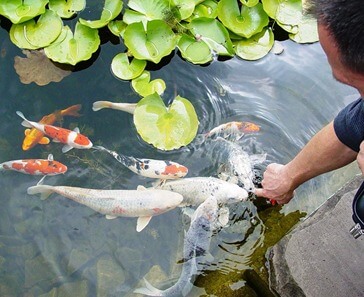
Salt Concentration/Level Measurement
The KoiMedic Salinity Tester and the Economy Salinity Tester are also available. These pond salinity meters are made specifically to measure the salt content in ponds. These meters are precise and simple to use. It’s as simple as turning it on and dipping it into the pond water.
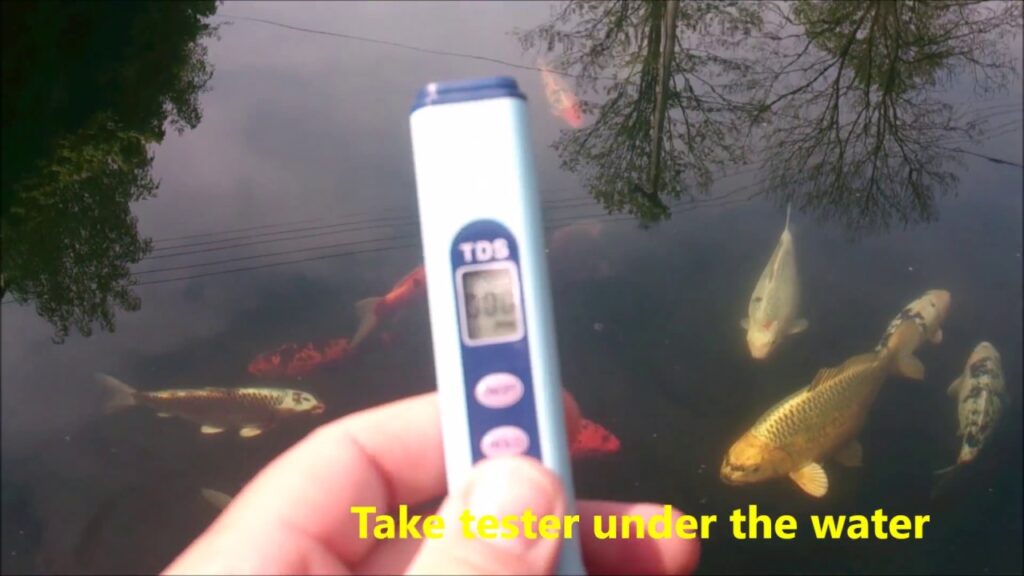
Let’s Get Some Salt Shaking
Pond salt is extremely good for both koi and pond water. However, too much salt might damage the fish and destroy the underwater greens. I’m confident you’ll have healthy, robust, and parasite-free koi fish and pond if you keep the dosage and salinity at the proper levels.
I hope that this blog has provided adequate information on which salt to use in a koi pond. Try them out and see the difference. And do let us know about it in the comments below…! We recommend that you always seek the advice of a specialist before performing any treatment. It is advisable in case of parasites to treat the fish in a quarantine tank.








